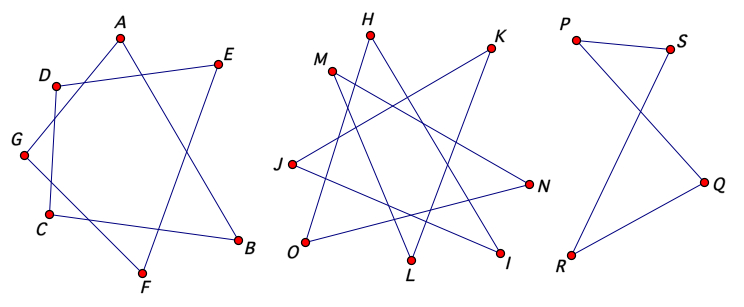Star pentagon and other crossed polygons
Explore: Drag vertices A, B, C, D or E. What do you notice about the Angle Sum of the star pentagon?
Challenge: Can you explain why (prove) it is true? Can you explain (prove) it in different ways?
Though there are several different ways of proving that the interior angle sum of a star pentagon like this is 180o, the above formula gives the result immediately since it's easy to see that k = 2 by rotating a pencil by the exterior angle at each vertex in order, and counting the total number of full revolutions it undergoes, walking all the way round the pentagon until returning to the starting position. Thus, S = 180(5-2x2) = 180o.
Explore Further: Can you now use this general formula to find the interior angle sum of the following polygons, namely, a crossed septagon, crossed octagon and a crossed quadrilateral?

1) Click on the appropriate Link to ... in the dynamic sketch above to check the interior angle sum for a crossed septagon like ABCDEFG. Then drag the septagon into other shapes and see if you can correctly predict or explain the shown interior angle sum.
2) Click on the appropriate Link to ... in the dynamic sketch above to check the interior angle sum of a crossed octagon like HIJKLMNO. Then drag the octagon into other shapes and see if you can correctly predict or explain the shown interior angle sum.
3) Click on the appropriate Link to ... in the dynamic sketch above to check the interior angle sum for a crossed quadrilateral like PQRS. Then drag the quadrilateral into the shape of a convex or concave quadrilateral (e.g. dragging S to the left across PQ), and then back again into a crossed shape. Can you explain (prove) what you observe? Why does the crossed quadrilateral have two reflexive angles? (Hint: consider directed angles by Evan Chen. The linked pdf also explains how, using directed angles, one can write solutions to math olympiad problems that cover all cases).
Notes & References
a) My 2012 book Rethinking Proof with Sketchpad has a learning activity with a worksheet and associated sketch in relation to the defining of 'interior angles' in terms of the concept of 'directed angles' so as to extend it in a consistent way to the interior angle sum of a crossed quadrilateral, and crossed polygons in general.
b) Read my 1989 IJMEST article From 'TO POLY' to generalized poly-figures and their classification: a learning experience which describes the background to my personal heuristic discovery & proof of the general 'interior angle sum' theorem.
c) Read my 1999 Math in School article Stars: A second look for a short proof of the formula, and for more examples, see Problem 15 on pp. 49-50 and the Solutions on pp. 135-136 of my book Some Adventures in Euclidean Geometry.
d) A suggested learning activity that starts with Turtle Geometry that provides a splendid conceptual background to the crucial idea of 'turning angle', and eventually guiding students towards the general interior angle formula is given at: Investigating a general formula for the interior angle sum of polygons.
e) Abelson, H. & diSessa, A. (1983). Turtle Geometry: The computer as a medium for exploring mathematics. Cambridge, MA: The MIT Press.
f) For another paper related to crossed quadrilaterals & their angle sum, read my 2015 paper in the Philosophy of Mathematics Education Journal, namely, I have a dream ... Crossed Quadrilaterals: A Missed Lakatosian Opportunity?
Related Links
Back
to "Dynamic Geometry Sketches"
Back
to "Student Explorations"
Michael de Villiers, created 2011; modified 4 February 2012, adapted to WebSketchpad 12 August 2021.